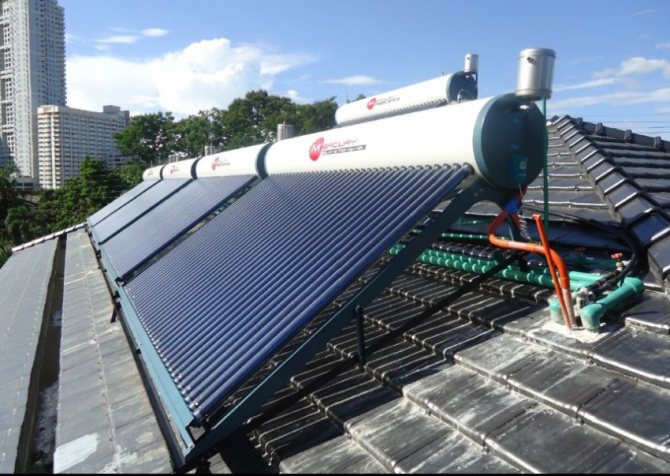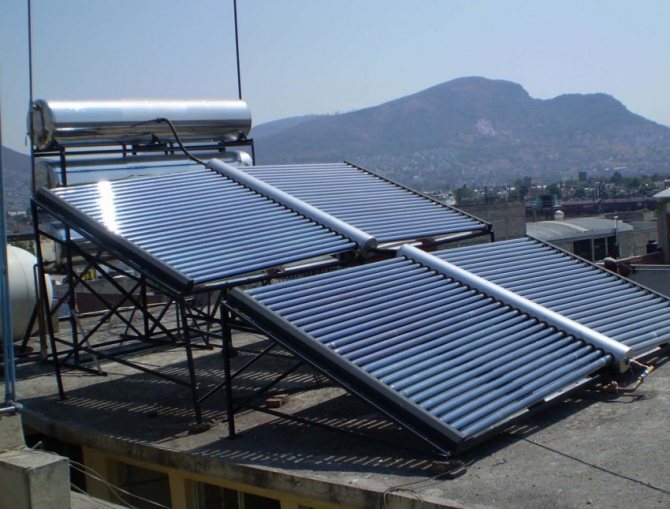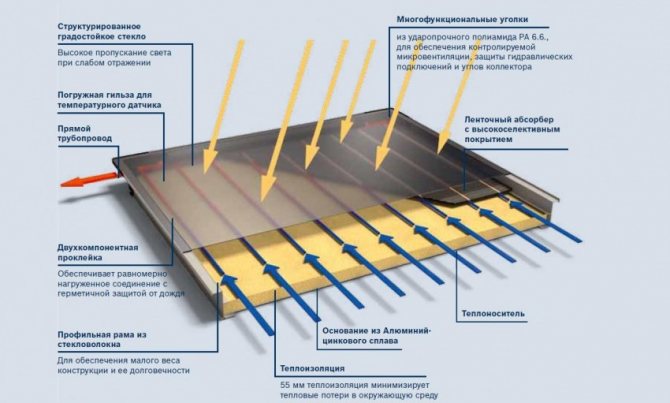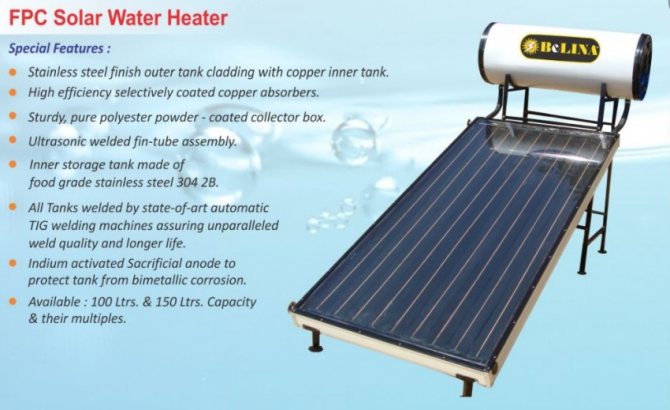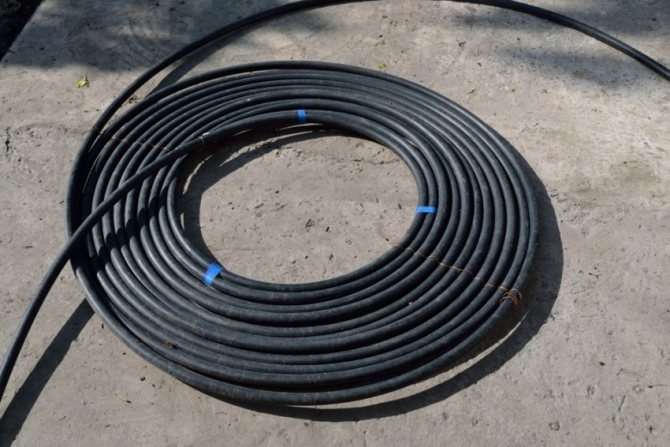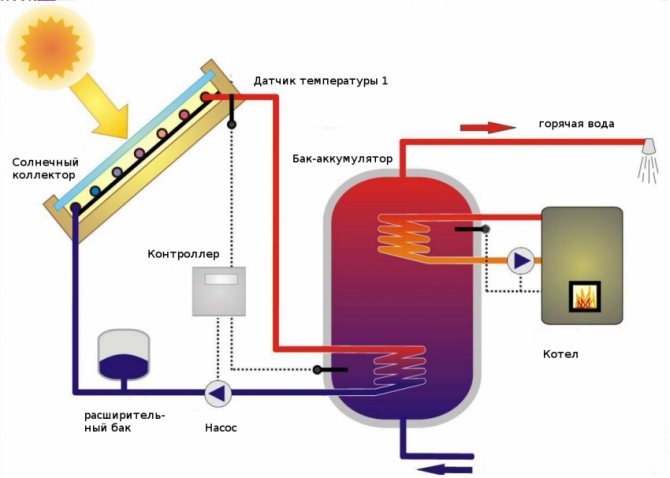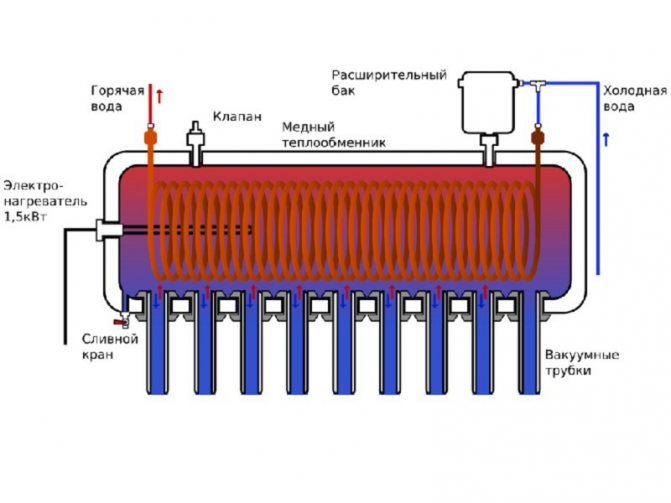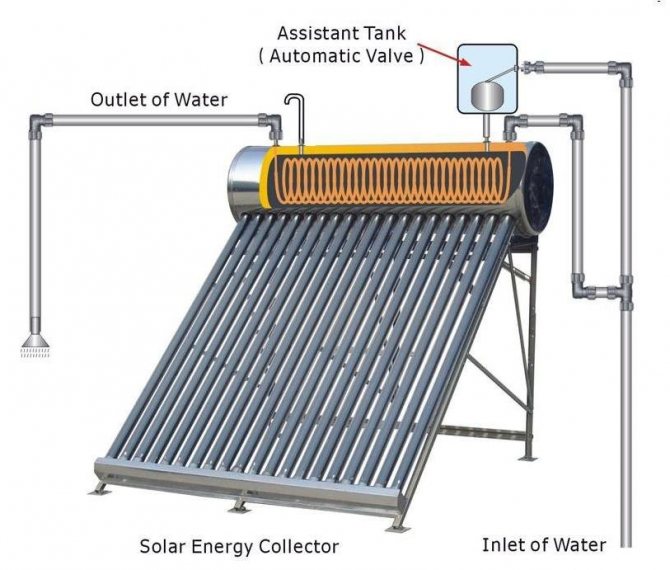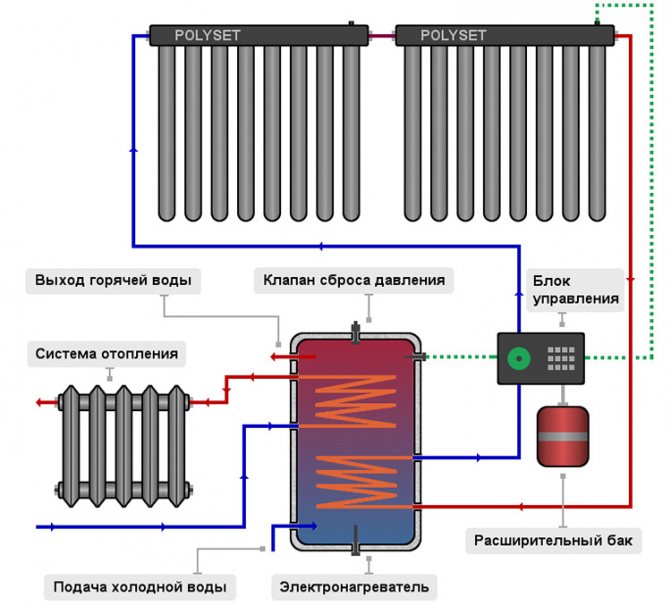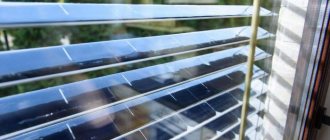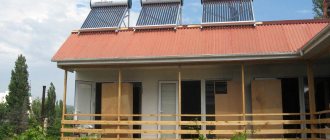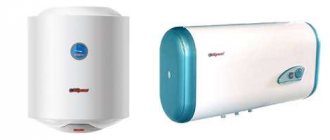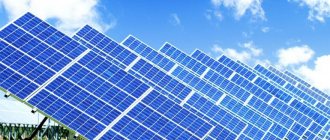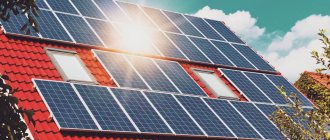The celestial body is the most powerful source of energy known to mankind. Sunlight can be converted into electrical and thermal energy. In this article, we will be interested in precisely the thermal energy, which we receive from the sun absolutely free of charge and it is inexhaustible. Devices such as solar water heaters convert the sun's energy into thermal energy. Factory devices have good performance and allow you to organize heating of a private house. There are craftsmen who make such devices on their own. Solar water heaters heat water free of charge to heat the home or for the boiler, where it already gives off heat to heat the water used for washing. Such devices are in demand among the owners of private houses and summer cottages. In this article we will talk about the principle of operation of solar water heaters, their types, main manufacturers and prices.
Solar Water Heater Working Principle
First, let's figure out how solar water heaters work. We will consider the operation of such a device using the example of a factory model of a vacuum water heater. It heats up the water in winter without any problems. Performance in winter is of course lower than in summer. The design of the water heater is a battery, which consists of several glass tubes of quartz glass. Each such tube contains a copper tube painted black. These inner tubes contain the heating medium. A vacuum is created in the glass tubes so that there is no heat loss from the internal circuit. In addition, the vacuum protects the battery from environmental influences. All pipes are connected to a horizontal collector through which the coolant circulates. The vacuum tubes absorb solar energy and release it to the water.

Solar Water Heater Working Principle
This system functions as follows:
- The working liquid (the liquid does not have to be water) evaporates under the influence of sunlight, and the vapor rises to the top of the glass bulb;
- The steam comes into contact with water through the wall, which circulates through the collector. The steam gives off thermal energy, cools and turns into liquid again;
- Under the action of gravity, the liquid flows down and so the cycle is closed;
- The collector of the water heater is connected by means of pipelines to the indirect heating boiler. There, water is already heated, which circulates in the heating or water supply circuit. The coolant is circulated by a pump.
The quartz glass from which the vacuum tubes are made transmits ultraviolet waves. Ordinary glass holds them back. Thanks to the transmission of ultraviolet light, solar energy is absorbed when it is cloudy and during the winter season. It is very difficult to make such a design at home.
There are water heaters with a less complex operating principle. In gravity water heaters, heat energy is transferred without an intermediary. Usually in their design there is a coil (copper, aluminum) on a metal substrate or without it. The back wall of the case is lined with heat-insulating materials. The coil is connected to the storage tank by means of pipelines. The coil and plate (also called an absorber) are painted black for better absorption of sunlight. The top of the case is covered with glass, polycarbonate, etc. And also thorough insulation has been carried out to prevent precipitation, dirt, dust from falling.
Such a simplified water heater works effectively only in clear weather.But due to the simplicity of the design, such water heaters are most often made by hand. In addition, there is another option to get a water heater powered by free solar energy. Solar panels are installed that generate electricity. And this electricity runs a conventional water heater. Such a system can also work all year round.
Green Way
Foreign applied and popular science literature (1127 books) Raising children (1440 books) Cooking (2298 books) Health (4249 books) Self-improvement (1787 books) Garden and Vegetable Garden (790 books) Sports, fitness (1726 books) Hobbies, Crafts ( 2537 books) Nature and animals (374 books) Home and Family: Miscellaneous (1591 books) Pets (252 books) Do it yourself (1153 books) =================== == Oil has dropped significantly in price, this is a political process, not an objective one. In the former Soviet republics, the growth of the dollar exchange rate is so high that payments for heating, hot water, gasoline prices, etc., are growing. And there is no end in sight to this process. The future belongs only to solar energy and renewable heat sources.
The sun warms the earth every day and is completely free. A simple calculation shows that with a monthly consumption of water for washing 100 liters per person, then about 90 kW * hour per month or 1080 kW * hour per year should be spent on heating it. At the same time, on a summer day in Kiev, in clear weather, the sun sends 1 kW * hour of energy per hour to a site with an area of 1 m2, or on average 8 kW * hour per day. Obviously, if you can use at least some of this free solar energy for hot water supply, then you can get significant savings. Hot water with a heating tank The simplest solar water system for a home is a heating tank. This is just a container for water, which is heated by the sun's rays during the day.


external black collectors made of plastic pipes for water heating
Nevertheless, such a simple solar heater is very effective for supplying warm water in the summer and is widely used for the so-called "summer shower".
Solar radiation map for Ukraine
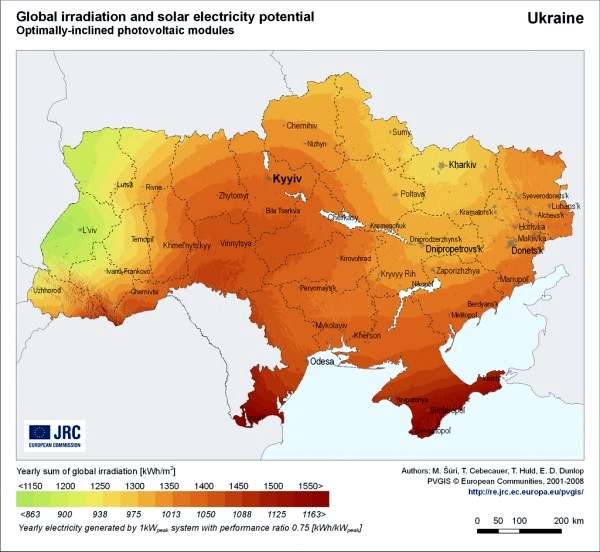

Solar insolation The concept of solar activity in modern science is associated with the term "solar insolation". Insolation is understood as the amount of radiation received during one daylight hours, or, simply put, the degree of "exposure" of 1 sq. M. land for a specific period of time. In this context, one should not be intimidated by the term "radiation", since here solar irradiation is a potentially useful energy resource and not a source of danger.
Specificity of measuring the level of solar activity The data necessary for calculating solar insolation are sent from NASA satellites. The obtained values are reduced to some average indicator, which allows you to systematize the information. The difficulty lies in the fact that it is impossible to accurately measure the amount of light hitting the ground, because the process of radiation exposure is exposed to many factors, for example:
- the height of the site above sea level and, accordingly, the remoteness of the sun from the area;
- season (also makes adjustments to the distance of the sun from the earth);
- weather conditions (cloudiness, fog, etc.);
- the angle of incidence of the sun's rays (varies by time of day).
Even taking into account all of the above factors, the resulting value cannot be considered universal. Any surface that prevents direct sunlight from hitting the earth's surface will affect the accuracy of the solar readings. Even such small details as the presence of fences on the territory are important.
From this point of view, the most attractive are Zaporozhye, Dnepropetrovsk and Lugansk regions, as well as resort Odessa, Kherson and Simferopol.A high level of activity is considered to be indicators of 5 kWh / m2 / day, and in the listed territories in the summer period the coefficient often exceeds the mark of 6 units (the record holders here are Nikolaev and Kherson with indicators of 6.03 and 6.04, respectively). But even in colder periods, the installation of solar collectors will not be superfluous: the average degree of exposure per year varies from 3.34 units in Lugansk to 3.58 in Simferopol.
Solar panelswill, however, be less effective outside the coastal zone. The average figures for Ukraine are comparable to the solar activity coefficient in northern Helsinki: 2.8 versus 2.41 kWh / m2 / day. The most unfavorable regions for the development of "solar" energy are Ivano-Frankivsk and Chernivtsi, where the average index for the year does not exceed 2.99 kWh / m2 / day. For details, see the table in the appendix.
DIY solar water heater from improvised means
If the heating tank is equipped with a tank for storing warm water, then you can get an even more efficient solar heating system that will supply you with warm water in summer and will pay off in a couple of seasons. Let's consider such a solar water heater in more detail. The most important part of the solar system is, of course, the heating tank itself. This can be any container for water, for example, a steel cube, a barrel, or several large diameter pipes. It is best to use a special polyethylene summer shower tank with a volume of 200-300 liters for this purpose. Such a tank has a flat shape, rational for heating, does not rust, is painted black for better heat absorption and, due to its low weight, is easily mounted on the roof. If such a tank is simply placed in direct sunlight, then on a hot sunny day the water in it heats up to 40-45 ºС by the end of the day, which is quite enough for domestic needs. But if the warm water is not used up in the evening, then during the night, by the morning it will cool down. Thus, warm water cannot be used around the clock. Obviously, to eliminate this drawback, it is necessary to "stop" the heat loss from heated water. This can be done either by insulating the heating tank at the end of the day, or by draining warm water into an insulated container. Given that most private households use gas and electric boilers, it is beneficial to use them to store warm water from a heating tank. Also, unlike the insulation of the heating tank, the draining process is less laborious, you do not need to go up to the place where the tank is installed. Moreover, since on a cloudy day the water in the heating tank heats up only to 25-30 ºС, it will have to be heated anyway. The figure shows a diagram of the operation of the simplest system for heating water with the sun, which you can assemble with your own hands. The water heating system consists of a heating tank, a boiler and a water supply system with three taps. First, the tap (3) is closed, the tap (1) and (2) are open. Water from the pressure water pipe (blue) is supplied to the heating tank. After filling the tank, the pressure water pipe is closed with a tap (1). At the end of the day, when the water in the heating tank heats up and needs to be drained into the boiler, the tap (3) is opened for this. If the heating tank does not need to be used, then you can simply close the tap (2) and the boiler is used as usual.
It is convenient to control the filling level of the tank with a water level sensor, which can be attached to the tank lid. For the water supply, metal-plastic or polypropylene pipes for cold water are well suited (since the pressure in the system is low). This method of heating water is extremely simple, but it has two serious drawbacks: - the heating tank must be filled and drained daily; - You can get heated water only in warm weather, when the air temperature is above +20 ºС.Passive solar water heater To heat water with solar heat not only in warm weather, but also in the cooler off-season (March, April, September, October), the heating tank cannot be used due to too high heat loss. To do this, it will have to be replaced with a more efficient solar collector. On the Internet, you can find many descriptions of effective active solar systems that require the use of automation. But consider the most simple and convenient passive solar water heater system, that is, one that works by itself without using a pump. First of all, you need to make a solar collector. If we analyze the many known designs of solar collectors, then we can come to the conclusion that the determining factor for the reliability, cost and ease of assembly of a solar collector is the material of its heat exchanger. The most reliable pipes are considered to be metal pipes, for example, thin-walled copper or steel, but they are expensive and laborious to assemble. In addition, the heat exchanger with metal pipes is heavy, which requires a sturdy box and complicates the installation. Heat exchangers made of polypropylene and metal-plastic pipes are more convenient and cheaper, but thermal deformations when heated by the sun and a large number of joints increase the likelihood of leakage and also increases the labor intensity during assembly. A heat exchanger from a garden hose is devoid of all these disadvantages. Its assembly consists only in the fact that the hose needs to be smoked in the form of a spiral. The lack of connections and flexibility of the hose guarantees no leaks, and the length of the hose allows water to be brought directly from the manifold to the pipeline inside the house without intermediate connections. The simplest solar collector from a garden hose is shown in the figure. It consists of a window glass (1), a hose (2) and foam as thermal insulation and a base (3). The principle of its operation is very simple - short-wave solar radiation passes through the glass, heats the hose with water. From the heated hose, radiation of an already long-wavelength spectrum begins, which is significantly reflected by the glass. Thus, the sun's rays fall into the so-called "heat trap". When installing a solar collector, the optimum tilt angle will be 35º in summer and 40º in spring-autumn. The figure shows the connection diagram of the solar collector to the boiler. Before the solar collector starts heating water, it is necessary to fill the hose with water and displace the air from it. To do this, close the tap (2) and open the hot tap of the sanitary fixture (6) to drain the water. Water from the pressure water pipe (1) begins to flow into the solar collector (4). After the air bubbles stop mixing in the drain water, it means that there are no air plugs in the manifold. Then tap 2 opens and cold water from the boiler under the influence of the thermosiphon effect (when the collector is heated by the sun) begins to flow into the collector. To turn off the solar collector and use heated water or operate the boiler in normal mode, close the tap (3). As you can see, the operation of this boiler does not require complex and expensive equipment, the only drawback of such a simple system is that you need to periodically turn on and off the water supply to the solar collector with a tap (3). In cloudy weather, the heating of water by such a solar collector occurs partially, the rest will be "heated" by the boiler, which still gives savings. Keep in mind that in cloudy weather or in the off-season, the boiler will have to turn on for heating at the end of the day, that is, when the water in the collector no longer heats up. Otherwise, when the water is heated in the TEN'om collector, it will stop circulating. To calculate the required performance of a solar heater, it is necessary to take into account that 1 meter of a hose with an outer diameter of 25 mm on a clear day at +25 ºС heats 3.5 liters of hot (up to + 45 ºС) water.And at +32 ºС it heats 3.5 liters of hot water up to + 50 ºС. The number of average hours of sunshine throughout the year for Kiev is shown in Table 1.
For example, if the length of the hose in the collector is 10 m in May, the solar collector's capacity will be 3.5l * 10m * 8h = 280 liters of hot water per day. The lower limit of the outside air temperature, at which savings are observed in clear weather, will be +5 to +8 ºС. In freezing conditions, it is best to drain the water from the collector, although this design is freeze resistant.
The hose for such a solar water heater is either rubber or PVC reinforced. The inner diameter of the hose should not be less than 19 mm, and more is possible. But if the diameter is smaller, then the hydraulic resistance of the system increases significantly, which slows down the natural mixing of water due to the thermosiphon effect. Also, writes iBud.ua, it is not advisable to choose a hose with a wall thickness of less than 2.5 mm, since a hose with thin walls does not hold its shape well and often bends. A garden hose is not expensive. So, a reinforced PVC hose with an inner diameter of 19 mm and a wall thickness of 3 mm, depending on the manufacturer, costs from $ 2 to $ 3 per meter. It is preferable to choose a hose in black or dark tones for better heat absorption. The difference, however, is not very big. For example, a white hose absorbs solar heat about 5% worse than a black hose. But the additional 5% will not be superfluous. For mixing water using the thermosiphon effect, the shape of the hose itself does not matter, since the water in the hose is evenly heated, the difference in levels between cold water in the boiler and hot water in the manifold is important. Therefore, for a stable thermosyphon effect to appear, the boiler must be raised above the upper part of the solar collector by at least 60 cm. You should also try to reduce the length of the supply pipeline as much as possible, since the longer the pipe, the greater the friction force that prevents water from flowing from the collector to storage (boiler). To reduce heat loss by convention, the back of the hose is insulated with foam. It is also necessary to seal the gap between the glass and the foam. To do this, you can place a soft foam pad between the glass and the foam, or glue the glass and foam with water-based glue (adhesives with an organic solvent can dissolve the foam). For example, you can use foam glue or PVA glue. To fix the shape of the solar heater hose in the form of a spiral, it is tied to a tube or bar. To attach it to the styrofoam, simply tie it. It is imperative to use window glass. Plexiglass or polymer film will not work, as they are very poor at blocking long-wave radiation. There should be a gap of 12-20 mm between the glass and the surface of the hose. The glass should not have reflective selective coatings (i-glass), such glass reflects a significant part of solar radiation.
When it comes to choosing between single and double glazing, there are two factors to consider. With double glazing, less heat loss, but more reflectivity of sunlight. And since the higher the ambient temperature, the less heat loss, it turns out: - if the solar heater will be used mainly in the warm season, then single glazing is better; - if it's cool, then double becomes more profitable. Hose leads that go out must be thermally insulated to reduce heat loss. For thermal insulation inside the heated room and when the length of the water pipes is not more than 3 m, it is enough to use the usual soft thermal insulation made of polyethylene foam for pipes. For longer sections, as well as for thermal insulation of external pipelines, it is necessary to use a more powerful rigid thermal insulation for pipes made of foil polyurethane foam.You can connect the hose to the pipeline using a rubber pipe clamp; for this, the hose is tightly put on the pipe and clamped with a clamp. It is optimal that the inner diameter of the hose is equal to the diameter of the pipe on which it will be put on. The described design of a passive solar heater with a collector can save up to 80% of energy for hot water supply in summer and up to 40% in spring and autumn, which will amount to about 400 kWh of energy saved per person per year. Author: Igor Solarov Chernivtsi
application
In approximately 80% of the territory of Ukraine, the level of insolation does not fall below 3 units, which, in comparison with other European countries, is a very promising result. This means that the installation of solar collectors can become a new round in the development of energy technologies both in Ukraine and in other southern European regions.
Solar insolation table by cities of Ukraine
| jan | feb | mar | Apr | May | june | jul | Aug | sep | oct | but I | Dec | year | |
| Simferopol | 1,27 | 2,06 | 3,05 | 4,30 | 5,44 | 5,84 | 6,20 | 5,34 | 4,07 | 2,67 | 1,55 | 1,07 | 3,58 |
| Vinnytsia | 1,07 | 1,89 | 2,94 | 3,92 | 5,19 | 5,3 | 5,16 | 4,68 | 3,21 | 1,97 | 1,10 | 0,9 | 3,11 |
| Lutsk | 1,02 | 1,77 | 2,83 | 3,91 | 5,05 | 5,08 | 4,94 | 4,55 | 3,01 | 1,83 | 1,05 | 0,79 | 2,99 |
| Dnipropetrovsk | 1,21 | 1,99 | 2,98 | 4,05 | 5,55 | 5,57 | 5,70 | 5,08 | 3,66 | 2,27 | 1,20 | 0,96 | 3,36 |
| Donetsk | 1,21 | 1,99 | 2,94 | 4,04 | 5,48 | 5,55 | 5,66 | 5,09 | 3,67 | 2,24 | 1,23 | 0,96 | 3,34 |
| Zhytomyr | 1,01 | 1,82 | 2,87 | 3,88 | 5,16 | 5,19 | 5,04 | 4,66 | 3,06 | 1,87 | 1,04 | 0,83 | 3,04 |
| Uzhgorod | 1,13 | 1,91 | 3,01 | 4,03 | 5,01 | 5,31 | 5,25 | 4,82 | 3,33 | 2,02 | 1,19 | 0,88 | 3,16 |
| Zaporizhzhia | 1,21 | 2,00 | 2,91 | 4,20 | 5,62 | 5,72 | 5,88 | 5,18 | 3,87 | 2,44 | 1,25 | 0,95 | 3,44 |
| Ivano-Frankivsk | 1,19 | 1,93 | 2,84 | 3,68 | 4,54 | 4,75 | 4,76 | 4,40 | 3,06 | 2,00 | 1,20 | 0,94 | 2,94 |
| Kiev | 1,07 | 1,87 | 2,95 | 3,96 | 5,25 | 5,22 | 5,25 | 4,67 | 3,12 | 1,94 | 1,02 | 0,86 | 3,10 |
| Kirovograd | 1,20 | 1,95 | 2,96 | 4,07 | 5,47 | 5,49 | 5,57 | 4,92 | 3,57 | 2,24 | 1,14 | 0,96 | 3,30 |
| Luhansk | 1,23 | 2,06 | 3,05 | 4,05 | 5,46 | 5,57 | 5,65 | 4,99 | 3,62 | 2,23 | 1,26 | 0,93 | 3,34 |
| Lviv | 1,08 | 1,83 | 2,82 | 3,78 | 4,67 | 4,83 | 4,83 | 4,45 | 3,00 | 1,85 | 1,06 | 0,83 | 2,92 |
| Nikolaev | 1,25 | 2,10 | 3,07 | 4,38 | 5,65 | 5,85 | 6,03 | 5,34 | 3,93 | 2,52 | 1,36 | 1,04 | 3,55 |
| Odessa | 1,25 | 2,11 | 3,08 | 4,38 | 5,65 | 5,85 | 6,04 | 5,33 | 3,93 | 2,52 | 1,36 | 1,04 | 3,55 |
| Poltava | 1,18 | 1,96 | 3,05 | 4,00 | 5,40 | 5,44 | 5,51 | 4,87 | 3,42 | 2,11 | 1,15 | 0,91 | 3,25 |
| Smooth | 1,01 | 1,81 | 2,83 | 3,87 | 5,08 | 5,17 | 4,98 | 4,58 | 3,02 | 1,87 | 1,04 | 0,81 | 3,01 |
| Sumy | 1,13 | 1,93 | 3,05 | 3,98 | 5,27 | 5,32 | 5,38 | 4,67 | 3,19 | 1,98 | 1,10 | 0,86 | 3,16 |
| Ternopil | 1,09 | 1,86 | 2,85 | 3,85 | 4,84 | 5,00 | 4,93 | 4,51 | 3,08 | 1,91 | 1,09 | 0,85 | 2,99 |
| Kharkiv | 1,19 | 2,02 | 3,05 | 3,92 | 5,38 | 5,46 | 5,56 | 4,88 | 3,49 | 2,10 | 1,19 | 0,9 | 3,26 |
| Kherson | 1,30 | 2,13 | 3,08 | 4,36 | 5,68 | 5,76 | 6,00 | 5,29 | 4,00 | 2,57 | 1,36 | 1,04 | 3,55 |
| Khmelnitsky | 1,09 | 1,86 | 2,87 | 3,85 | 5,08 | 5,21 | 5,04 | 4,58 | 3,14 | 1,98 | 1,10 | 0,87 | 3,06 |
| Cherkasy | 1,15 | 1,91 | 2,94 | 3,99 | 5,44 | 5,46 | 5,54 | 4,87 | 3,40 | 2,13 | 1,09 | 0,91 | 3,24 |
| Chernihiv | 0,99 | 1,80 | 2,92 | 3,96 | 5,17 | 5,19 | 5,12 | 4,54 | 3,00 | 1,86 | 0,98 | 0,75 | 3,03 |
| Chernivtsi | 1,19 | 1,93 | 2,84 | 3,68 | 4,54 | 4,75 | 4,76 | 4,40 | 3,06 | 2,00 | 1,20 | 0,94 | 2,94 |
The first ever solar water heaters
The first solar water heater was developed back in 1767. It was invented by an ordinary resident of Switzerland ─ Horace Bnedict de Saussure. In his invention, he was able to achieve simply boiling water. But then it was already a success. And the Swiss inventor started selling his water heaters.
Horace Bnedict de Saussure
In 1953, the device was improved in Israel. Scientist Zvi Tavor even received an award for this from the country's prime minister. This simple water heating technology is still popular in our century.
How to make the simplest solar water heater model
The simplest solar water heater solution is a black painted barrel mounted on the roof. The intra-house pipeline is connected to this barrel and supplies heated water to the distribution points.
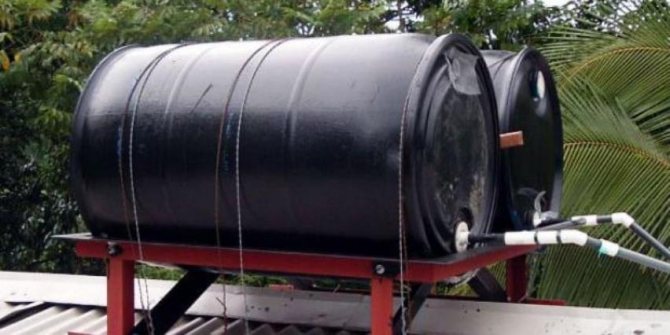

The barrel can be replaced with a simple, rather shallow trough, closed with a transparent lid. In both cases, the system should include:
- cold water supply pipe;
- overflow pipe;
- locking elements;
- heated water outlet pipe.
However, in cloudy weather, both of these options are characterized by extremely low efficiency. As for the use of the trough, the matter is complicated by the need to keep it in a horizontal position. This does not allow the container to be placed in such a position relative to the sun, which ensures maximum water heating.
Are you interested in questions related to solar panels? You can find a lot of interesting information on this issue in this article.
Varieties of solar water heaters
Now let's talk about the types of solar water heaters. They are classified according to various design features.
For example, the following water heaters are distinguished by the type of coolant circulation:
- With natural circulation;
- With forced.
In the first case, water circulates due to its physical properties. When heated, it increases in volume, its density decreases. As a result, the liquid rises through the tubes, and cold water enters its place. For natural circulation to pass, the reservoir must be on top of the collector, and this is not always convenient.
In the second case, the storage tank is installed in the basement, and forced circulation is provided by special pumps. With such an organization, oil can play the role of a heat carrier. It does this function very well.
Water heaters can be classified by collector design:
- Vacuum. The coolant is in a tube that is sealed in a vacuum flask.This bulb is made of quartz glass that transmits solar heat, as well as ultraviolet light. These are highly efficient designs where heat loss is minimal. If water is used as a heat carrier, then heating occurs to a boil. If there is oil there, then it can be heated up to 200-300 degrees. Almost all vacuum water heaters are factory-made and are quite expensive;
- Panel. The design is the simplest. The collector is painted black, housed in an insulated casing and hermetically sealed with glass, plastic, polycarbonate, etc. The efficiency is poor. This is because the fluid loses some of its heat as it passes through the manifold. These losses are usually quite significant. Panel solar water heaters are well suited for regions with high solar insolation.
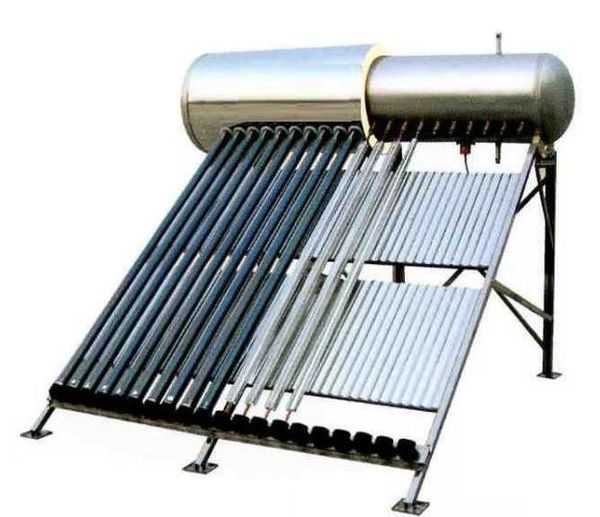

Closed Loop Solar Water Heater
In addition, water heaters can be classified according to the type of circuit:
- Open loop. This design is used when organizing hot water supply to a residential building. Water acts as a coolant, which after heating no longer gets back into the collector. It is spent on household needs;
- One closed loop. It is used for heating a residential building. In this case, the coolant from the water heater is mixed with another liquid (possibly not water) that was heated in the main boiler. In a closed loop, the coolant, after heating, passes through the heating system and returns to the collector again;
- Two closed contours. Such water heaters are versatile and the most efficient. This system can be used to generate hot water or heating all year round. Having heated up in the collector, the coolant goes to the heat exchanger and transfers heat to the second circuit. And already the coolant in this second circuit is consumed as hot water or for heating the house.
The coolant can also be different. The most commonly used water, antifreeze, oil. You can also subdivide water heaters according to the general principle of operation into passive and active systems.
- Passive. Energy absorption and accumulation occur by themselves without any control mechanisms. Such systems are simple and do not require serious investments. For this you have to pay with uneven work and power surges. An example is the tank above the summer shower, which is painted black. This is usually the case for single-loop systems. Here, the receiving tank should be above the manifold;
- Active. There are no downsides to a passive water heater. Here solar energy is converted into thermal energy and is periodically transferred to a storage tank, boiler or directly to consumers. Stable operation is achieved thanks to the forced circulation system. This scheme works in systems with one and two circuits. In such systems, you can often see pumps, panels, gauges, etc.
Solar water heaters from trusted manufacturers
The economic benefit from buying a heating boiler depends on several factors:
- high price;
- heat transfer;
- payback period;
- operating time.
Not all solar water heaters function the same. When using installations made from cheap and low-quality raw materials, one may encounter problems of use: productivity will drop, equipment will fail prematurely. In order not to face disappointment, you need to buy equipment from trusted manufacturers. Let's find out which manufacturers are best to trust?
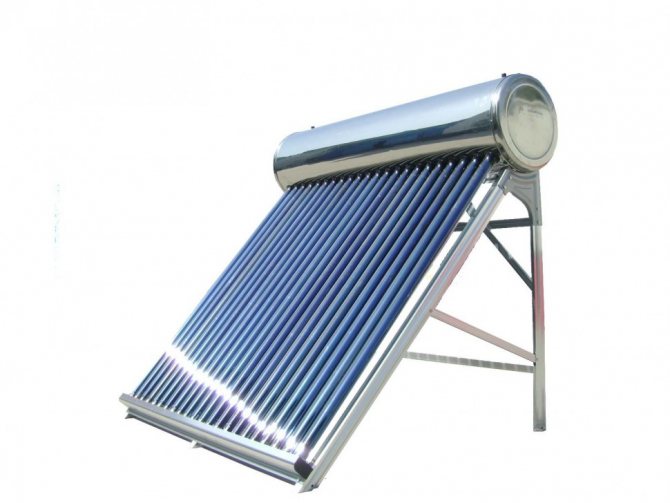

Passive solar water heater
Below is a list of reliable manufacturers who make quality and affordable units:
- Atmosfera is a Ukrainian manufacturer that creates vacuum and panel installations for year-round water heating and heating systems support. These water heaters are designed for devices with forced circulation and have high thermal insulation.There is a place in the case for installing monitoring sensors. Many users have noted the high performance of the systems in cold and rainy weather. You can buy a boiler from 20 thousand rubles;
- Side is a Chinese company that has established the production of solar water heaters and related devices needed for maintenance and connection. On the market you can find tubular and panel devices, as well as turnkey solutions for equipping swimming pools, offices, production sites, hospitals, schools. Boilers of this brand are still only gaining popularity among domestic consumers;
- Vaillant auroSTEP plus - solar collectors with excellent German build quality and affordable price. You can buy this system for at least 200 thousand rubles, and provide a family with hot water for 3 people;
- SunRain is another Chinese-made model. These installations operate when the temperature drops to -50 degrees. The manufacturer implements horizontal and inclined installation. Installations can operate throughout the year. They are connected to a remote container. The price of tubular collectors is from 40 thousand rubles;
- Viessmann Vitosol is a German manufacturer that produces water heating equipment. The main difference from analogs of other manufacturers is the high-quality assembly, which fully meets the stated requirements. There is also an anti-vandal and anti-hail system;
- YaSolar is a Russian company that produces turnkey hot water supply equipment. The complete set consists of a storage tank, a controller, heating sensors, a pumping station and an air vent. The solar collectors produced under this brand are designed to be connected to forced circulation systems.
Recommended: How to install solar greenhouse heating with your own hands?
Compliance with safety regulations and recommendations for connecting solar water heaters is the main prerequisite for commissioning the systems. If the connection conditions are violated, their effective operation is not guaranteed.
YouTube responded with an error: Access Not Configured. YouTube Data API has not been used in project 268921522881 before or it is disabled. Enable it by visiting https://console.developers.google.com/apis/api/youtube.googleapis.com/overview?project=268921522881 then retry. If you enabled this API recently, wait a few minutes for the action to propagate to our systems and retry.
- Similar posts
- Is it possible to make a solar collector for home heating?
- Pros and cons of solar panels for home heating
- How to install solar heating in a greenhouse with your own hands?
Applications and installation requirements
So where are solar water heaters applied?
- Hot water supply of a private house;
- Heating;
- Heating of water for summer cottages;
- Hot water for the needs of agriculture and industry.
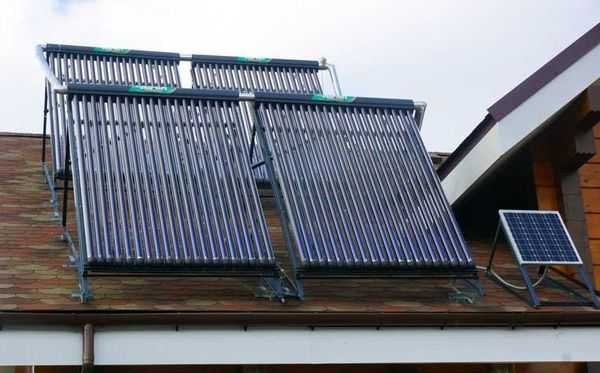

Solar water heater for home heating
It is important to take into account the installation recommendations, since the efficiency of the water heater will fully depend on this. Here are some of the recommendations of the experts:
- The place of installation can be the roof of the house, facade, balcony;
- The water heater panel must necessarily face south;
- When installing the panel, make the angle of inclination equal to the latitude of your region;
- Since the water heater constantly receives solar energy, with little water consumption, stagnation can form, where the coolant may well heat up to 300 degrees. Therefore, it is forbidden to use pipes made of plastic and galvanized iron. It is best to make a coil made of copper or stainless steel;
- It is imperative to insulate the heating elements of the water heater so as not to accidentally burn yourself;
- When choosing fasteners and insulation, one should also take into account the possibility of stagnation of the coolant and its strong heating. That is, it is better to choose materials with a safety margin. Many reputable manufacturers write the stagnation temperature in the specifications or on the device case. Focus on this value;
- Solar water heater panels should be located in an open area with maximum sun exposure. There should be no tall objects around that cast a shadow;
- To increase the efficiency of the water heater, it is necessary to fasten it on a special rack, if such an installation scheme is offered by the manufacturer;
- During installation, each type of heater can have its own characteristics. Here you need to focus on the manufacturer's recommendations.
Main manufacturers
Solar water heaters have found wide practical application in many European countries, China, Turkey, USA, Israel, Saudi Arabia. The production of these products in the world is growing steadily and, along with the demand, the number of companies in this segment is increasing.
Let's take a look at some of the big solar water heater companies. So, the top manufacturers in the world market:
- The Italian company produces KAIROS VT vacuum collectors. Available in 15 or 20 tube versions;
- The German manufacturer offers three models SKR21, SKR12, SKR6;
- Another German company that produces models with 6 or 12 pipes. Moreover, they can be combined into blocks to increase the power of the system;
- Sunrain Solar Energy. It is a Chinese manufacturer that produces solar water heaters;
- And another German company that offers two water heaters under the Vitosol 200 and 300 brands. These models differ in the design of the heating unit;
- Italian manufacturer producing the Ecotube model.
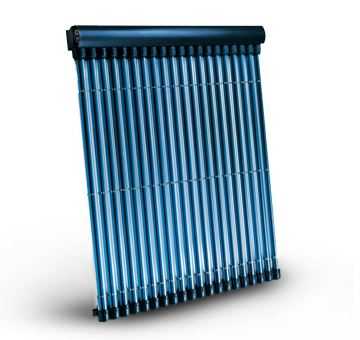

Water heater KAIROS VT
It is worth saying here that the products of these companies belong to the highest class and are provided with a guarantee, but not everyone can afford it. Therefore, most of the market demand is covered by little-known manufacturers.
Why homemade solar water heaters are so attractive
The advantages of homemade solar water heaters are quite obvious:
- the costs of them pay off pretty quickly;
- like factory models, they save fuel and, consequently, money;
- the product is ready for use almost immediately.
So, now you know the basics of this issue and are ready to design and make your own solar water heater. By doing it, you will be able to significantly reduce the costs associated with the maintenance of your home.
Prices and what do they depend on?
With regard to specific figures, water heaters produced in Russia will cost about USD 700 - 800. This is a vacuum type model. Roughly the same prices for similar Chinese products. Water heaters from German manufacturers cost about 800-900 euros. It is more expensive, but they have the necessary fasteners in the kit, and copper and stainless steel are used for the manufacture of collectors. So that money will not be spent in vain.
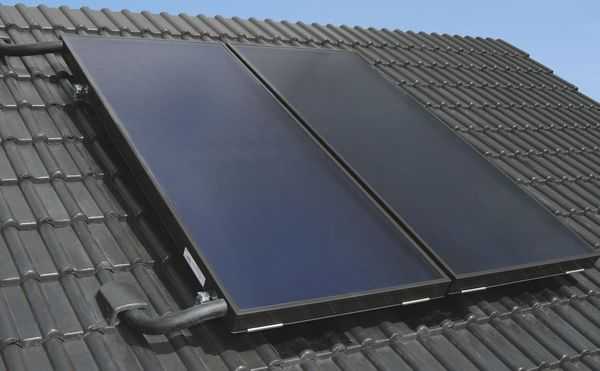

Water heater Viessmann Vitosol 200
The following factors influence the price of a solar water heater:
- Brand;
- Body and heat sink material;
- build quality;
- the method of laying the insulating material and the cost of the material itself;
- glass thickness.
Naturally, the design differences, which were described above, are reflected in the price.
Using solar energy with the help of modern technologies, you can easily provide your private house or garden house with hot water.
And you need to make an initial investment, and then the installation will work for free. If you want to save money, then make a solar water heater yourself. But factory systems are, of course, more reliable and functional. If the article turned out to be useful to you, spread the link to it on social networks. This will help the development of the site. Vote in the poll below and rate the material! Leave corrections and additions to the article in the comments.
How to make a full-fledged solar water heater with your own hands (video)
The main elements of this device are:
- make-up tank;
- storage tank;
- collector.
The following video describes in sufficient detail how to make a solar water heater:
According to experts, the pump should not be installed in the system.The water must circulate naturally. To achieve this effect, the tank must be installed above the heat sink, while the make-up tank must be above the storage tank. Another practical recommendation from experts is to install thermal insulation on a tank containing heated water. To do this, you can use any roll insulation.
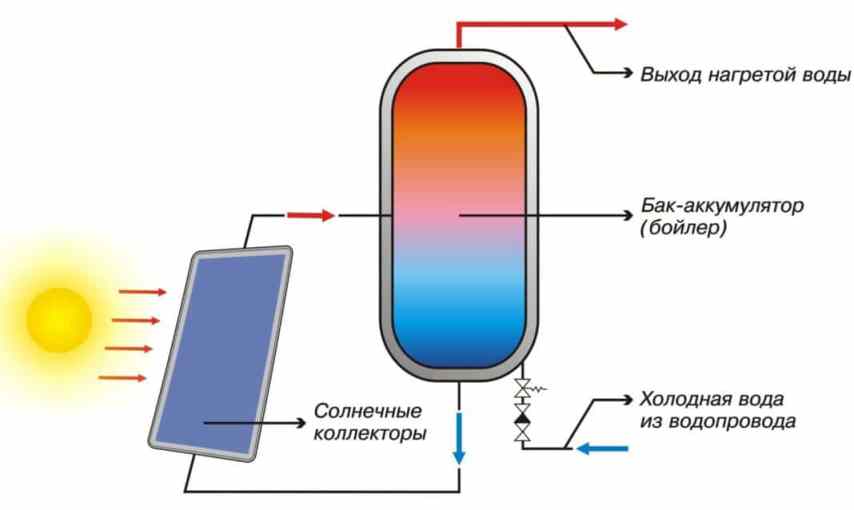

To automate the process of replenishing water in the system, the second tank should be equipped with a float valve.
The system must also have a vertical air outlet. To be more effective, it is usually raised to a fairly decent height.


